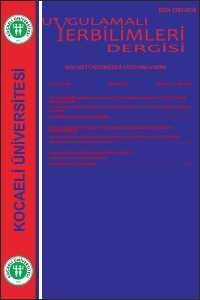Geophysical and Geotechnical Studies for Electric Power Plants Project at the Sakarya River Zone, Turkey
Geophysical and geotechnical studies were conducted at a proposed hydroelectric power plants facility at a site north of Sakarya river D100(E-5) bridge in Adapazarı town of Sakarya city in Turkey. The study is aimed at evaluating the competence of the near surface formation as foundation materials. Geophysical and geotechnical methods of investigation were adopted. The geophysical investigation involved the Vertical Electrical Sounding (VES) technique using the Schlumberger configuration, seismic refraction and geotechnical investigative methods comprised of boreholes to 40 m depth with Standard Penetrating Testing (SPT) and undisturbed Shelby tube, disturbed Split Spoon soil sampling, triaxial compresssion and consolidation tests. A total of five Vertical Electrical Soundings (VES) and five seismic refraction profiles from different location within the study area were used for the study. Water content, plasticity, and grain size distribution characteristics are obtained from laboratory testing leading to a classification of soils using the Unified Classification System. The geophysical results revealed three distinct geoelectric sequences which comprises of topsoil, weathered and partially weathered layers. The topsoils composed of clay/silt/sand while the weathered layer composed of silty sand. The partially weathered layer is formed of silty clay. The geotechnical results show that the partly weathered layer has relatively high clay content. Based on the consistency limits of the soils within the area, the soil generally indicate firm plasticity, hence, the soils are expected to exhibit medium swelling potential. There is no evident of geological feature such as fracture/fault within the subsoil in the area.
Anahtar Kelimeler:
Sakarya River, seismic refraction
___
- Akintorinwa OJ, Adeusi FA (2009) Integration of geophysical and geotechnical investigation for a proposed lecture room complex at the Federal University of Technology, Akure, SW, Nigeria, Journal of Applied Science 2(3), 2009. 241-254
- ASTM, American Society for Testing and Material (1985) Annual Book of ASTM Standards Soil and Rock, Building Stones, Section-4, Construction, V.04.08, ASTM Publication, 972, 166–194
- Bozkurt A, Kurtulus C (2009) Integrated geological, geophysical and geotechnical exploration for site characterization in Alikahya region, (NW Turkey), Uygulamali Yerbilimleri Dergisi, sayı, C8, 1-17
- Gibbs HJ, Holtz WG (1957) Identification and Classification of Soils An Appraisal, and Statement of Principles ASTM-STP 113 American Soc. for Test and Mat Philadelphia 3-24, 85-91
- Gutenberg B, Richter CF (1944) Frequency of earthquakes in California. Bull. Seismol. Soc. Amer, 34, 185–188
- Ishomoto, M., Lida, K., 1939. Observations of earthquakes registered with the micro- seismograph constructed recently. Bulletin of the Earthquake Research Institute 17, 443–478.
- Kurtulus C, Bozkurt A, Endes H, Alkan MA (2010) Engineering and physical characteristics of the Akveren formation, NW of Turkey, 14 ECEE, 1, 645
- Leonards GA (1962) Foundation Engineering Mc. Graw-Hill Book Company 11363 NewYork USA 3-24, 85-91
- Luna, R, Jadi, H (2000) Determination of dynamic soil properties using geophysical methods. Proceed-ings of the First International Conference on the Ap-plication of Geophysical and NDT Methodologies to Transportation Facilities and Infrastructure—Geophysics 2000. Federal Highway Administration, Saint Louis, MO. Paper No. 3 –1, 15
- Meyerhof G (1965) Shallow foundations. Journal of Soil Mechanics and Foundations Division, 91(SM2): 21 – 31
- ISSN: 1302-0218
- Başlangıç: 1996
- Yayıncı: Kocaeli Üniversitesi
